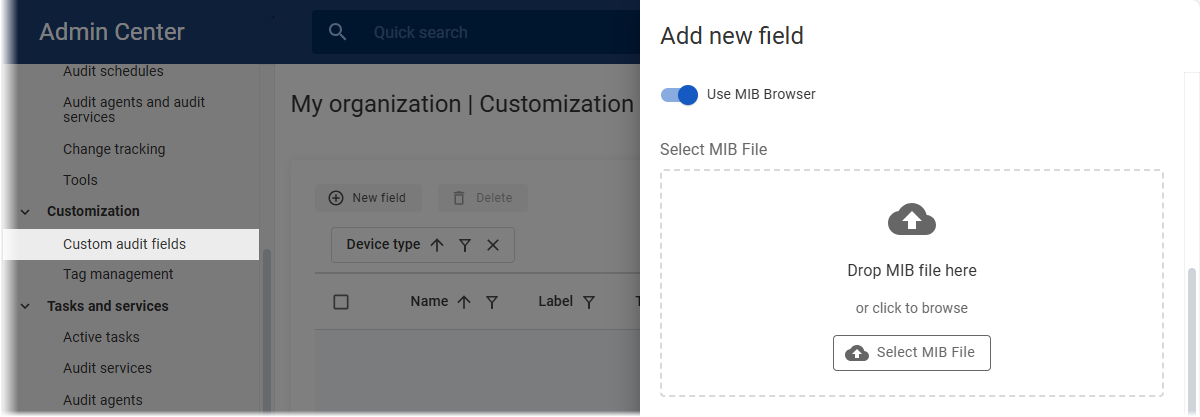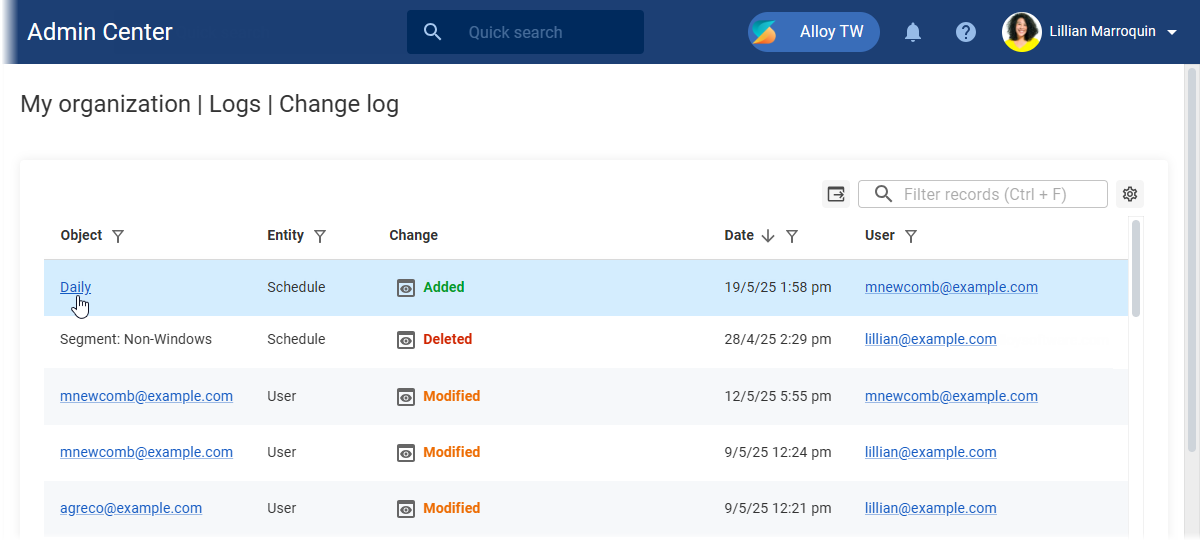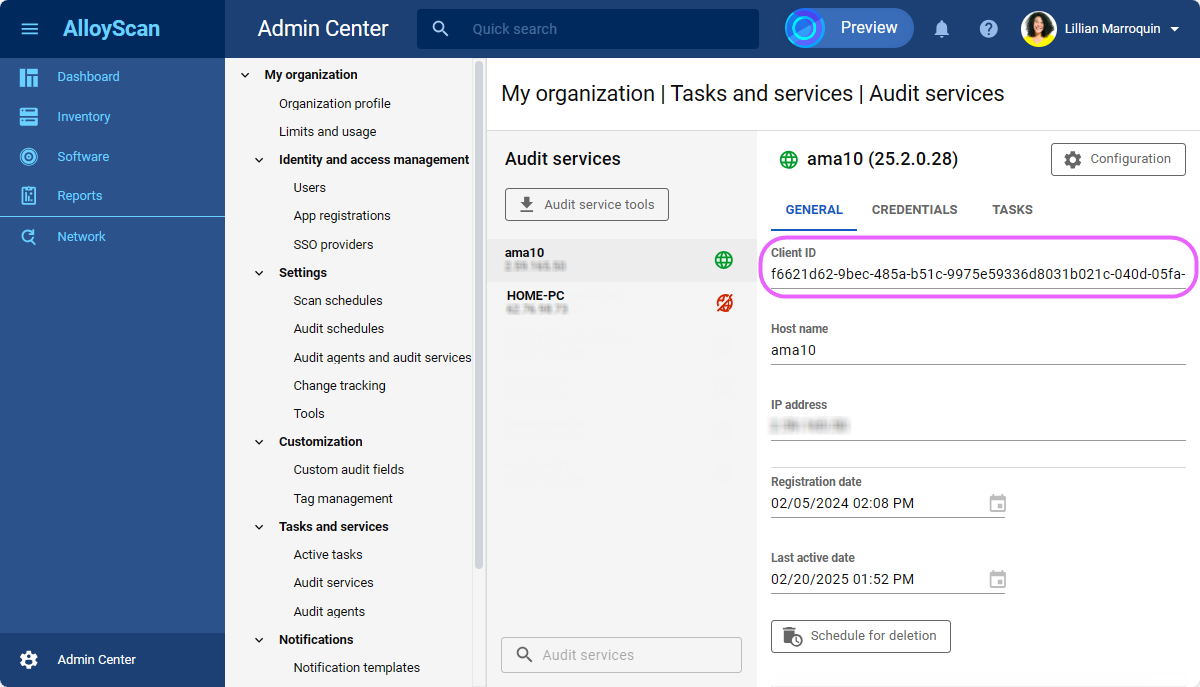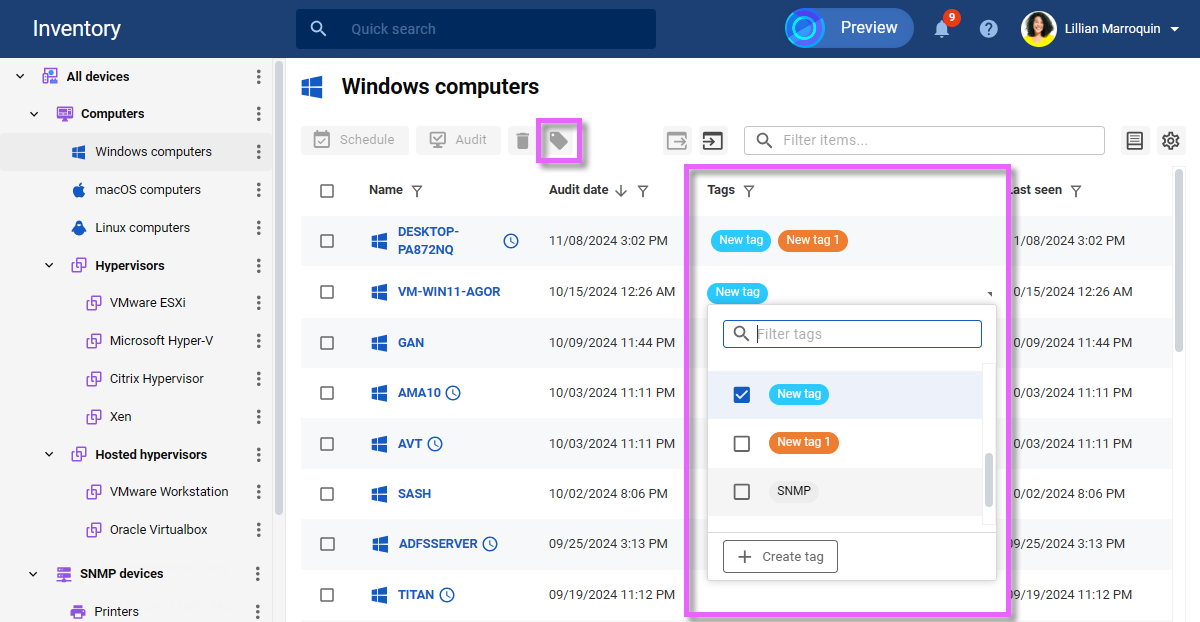What's new in AlloyScan 25
Updated: July 28, 2025
Check out the summary of changes we made to AlloyScan in 2025.
25.10 |
July 28, 2025 |
|
|
Open linked records without losing your contextIntroduced the ability to open related records directly on the current page, preserving your workflow and context. For example, you can now access the linked app registration from the expiration banner or the device details from the audit agent record. Additional scenarios will be supported soon.
|
Custom fields for SNMP devices: MIB-based value selectionExtracting precise device data via SNMP just got simpler and more accurate. You can now load a vendor-provided MIB file and select a specific branch to automatically fill in the OID and label when creating a custom field. This reduces setup time and ensures that the field pulls exactly the data you need from the device.
|
|
Improved visibility into audit agentsCentralized tracking of installed agents in the Admin Center (My organization > Tasks and services > Audit agents) is now more efficient with the following enhancements:
|
|
Straightforward tracking of grouped audit tasksPreviously, grouped audit tasks stayed listed under active tasks in the Admin Center (My organization | Tasks and services | Active tasks) until every individual task was completed. Now, monitoring is more straightforward: active tasks remain in the active list, while completed ones move to the audit log (My organization | Logs | Audit), with both still accessible within their group. |
|
|
|
Fixed bugs and improved usability. |
25.9 |
July 14, 2025 |
|
|
SNMPv3 initialization fix: SHA-2 support addedAddressed the issue where SNMP scans were failing with the error "Connection test failed. Reason: Failed initializing SNMP (Request timed out after 2000-ms.)." The fix involves adding support for SHA-2 (including SHA-512) in SNMPv3 authentication. |
| Other bug fixes and usability improvements. | |
25.8 |
June 26, 2025 |
|
|
Introduced change history reportsTwo new default reports — Device Change History and Software Change History — provide clear insight into changes, helping you easily track configuration updates over time. |
Improved device identification algorithmWe've improved the algorithm for assigning unique device identifiers (AuditId) to prevent duplicates and ensure consistent identification of all audited devices. Existing records are automatically updated during the upgrade. |
|
Queued audit processing for improved performanceAudit snapshots submitted by agents and services are now added to a processing queue instead of being handled immediately. This change improves performance and stability, especially in high-volume environments, ensuring smoother processing even during peak loads. |
|
Credentials persist after audit service reinstallationCredentials linked to audit services are now preserved during service reinstallation. This helps ensure uninterrupted auditing when reinstallation is necessary. |
|
|
|
Improved the error message when saving audit credentials while the audit service was unavailable. Instead of the vague "Bad Request. Target Audit Service Not Active," it now explains the issue and offers guidance to resolve it. |
|
In some environments, newly installed agents failed to send audit data due to server errors (e.g., 502 Bad Gateway). When this happened, the audit data was lost, no record appeared in the Inventory, and the only recovery option was to reinstall the agent, which was a significant challenge at scale. Now, if the agent doesn't receive server confirmation after submitting audit data, it automatically retries every 8 hours. This helps prevent data loss and eliminates the need to reinstall agents. |
|
| Other bug fixes and usability improvements. | |
25.7 |
June 6, 2025 |
|
|
Audit trail for configuration settingsThe Change log has been implemented to track modifications to AlloyScan settings by recording who made the changes, what was changed, and when, with the ability to drill down into the changed entities. It logs actions such as adding or editing segments or inventory groups, creating or modifying users or API registrations, and updating audit schedules.
INFO: For details, see Help: Change log. |
Troubleshooter improvementsWhen the troubleshooter checks a remote computer and fails to connect via WMI, it now additionally verifies the availability of the RPC server port. If the RPC port is unavailable, the error message explicitly states this. Otherwise, only the system WMI connection error is shown. |
|
Displaying multi-type custom fields as one columnAdded the ability to display custom audit fields representing the same data across computers and SNMP devices (such as Uptime) as a single unified column in the Inventory data grid. Previously, separate fields for computers and SNMP devices had to be added individually to combined data views. Now, by creating custom fields with the same label for both device types, you can add just one field to combined views to show data for both. For instructions on adding custom fields, see Help: Custom audit fields. |
|
No more duplicate license expiration emails for site adminsTo avoid duplicate notifications, AlloyScan no longer sends license expiration emails to site administrators. Push notifications and in-app banners remain active. Global administrators still receive email notifications about instance-level license expiration. |
|
PATCH support added to AlloyScan API for incremental updatesPATCH methods have been implemented for 29 existing PUT methods in the API. Unlike PUT, which replaces entire entities, PATCH allows partial, incremental updates by modifying only the properties included in the request. All PATCH method properties are optional. This improvement provides more flexible and efficient updates, reduces the risk of accidental data loss, and improves performance. |
|
|
|
Updated field names in API responsesWe fixed inconsistencies in several API responses:
If you use custom integrations, please review your setup to ensure compatibility. If you use custom integrations, please review your setup to ensure compatibility. |
Fixes and improvements for sync with Alloy Navigator
|
|
Improved device display on Network gridThe Network data grid now shows device manufacturers from audit data when available. Previously, it always displayed the manufacturer from discovery data, which sometimes caused incorrect information for audited nodes (e.g., computers behind Cisco IP phones shown as "Cisco"). |
|
| Other bug fixes and usability improvements. | |
25.6 |
May 8, 2025 |
|
|
Refreshed Admin CenterThe Admin Center has been updated with a consistent, structured design. Standardized layouts, pages, and UI elements now deliver a smoother, more cohesive user experience.
|
Optimization and scalability improvements
|
|
|
|
Fixed bugs, enhanced stability, and improved usability. |
25.5 |
April 14, 2025 |
|
|
Improved scalability for large deploymentsImproved performance and reliability of mass updates in large-scale deployments. |
Optimized agent behaviorUnified audit agent installers, smarter request handling, and improved caching for better performance and stability. |
|
|
|
Minor bug fixes and usability improvements. |
25.4 |
March 21, 2025 |
|
|
Regional formats from user’s browserAlloyScan now automatically applies regional formats for dates, times, and numbers based on the user’s browser locale. |
Compact date and time formatUsers can now display dates and times in a more compact format, making room for more columns in data views—especially useful on smaller screens. The format can be customized with options like two-digit years, abbreviated months, omitting seconds, and the 24-hour format, all adjustable in personal account settings.
|
|
Optimized field widthsInput fields for integer, date, and date/time values now align with their actual data limits for a cleaner UI. Standard integers fit within appropriate widths, while larger values get extra space as needed. |
|
Auto-generated site avatarsSites without a custom avatar now get a unique, auto-generated one. These avatars use the site's title initials and come in different colors, making it easy to distinguish between sites at a glance.
We’ve also enhanced the UI for uploading site avatars to provide a better user experience. |
|
|
|
Resolved issues with displaying custom fields on the device audit data form in Alloy Navigator when synced with AlloyScan. Also fixed the View in AlloyScan button, which was unresponsive in some cases. |
|
Resolved an issue where duplicate templates for conditional notifications could appear in the Admin Center under specific conditions. |
|
| Audit agents now log their first audit task, which runs immediately after installation on target computers. Supported on Windows, Linux, and macOS. | |
| Improved detection of serial numbers for the latest versions of Windows and Microsoft software products, including SQL Server, Office, Outlook, Project, Visual Studio, and Visio. The collected data enables software licensing compliance monitoring for these products in Alloy Navigator when synced with AlloyScan. | |
| Other bug fixes, usability enhancements, and security improvements. | |
25.3 |
March 6, 2025 |
|
|
Resolved an issue where users received an invalid password reset link on instances with a three-level domain. |
|
Resolved issues with auditing switches, printers, and other SNMP devices via SNMPv3, despite correct SNMP credentials. |
|
|
Other minor bug fixes and usability improvements. |
|
25.2 |
February 20, 2025 |
|
|
Unique identifiers for audit agents and servicesInstead of relying on host names, audit agents and audit services now use a unique identifier for registration in AlloyScan, eliminating potential conflicts. Previously, host name-based registration could cause issues when multiple computers shared the same name within a network. With this new approach, registration is seamless and collision-free.
|
|
|
Resolved an issue where existing hypervisor credentials were not applied to new segments. |
|
Other minor bug fixes and usability improvements. |
|
25.1 |
January 29, 2025 |
|
|
Introducing tags for better inventory organizationWe’ve added tags—colorful labels that help you organize and classify your inventory more effectively. Tags let you apply flexible, multi-category classifications to inventoried devices, adding more context and making it much easier to locate information. You can tag records directly from the Inventory section, either individually using the Tags column or in bulk using the Tags Administrators can manage all tags and track their usage in the Admin Center, under My organization | Customization | Tag management.
INFO: For details, see Help: Tagging records. |
Streamlined audit schedule managementWe’ve enhanced the UI/UX for managing audit schedules, making it more intuitive, simpler, and consistent. |
|
Improved notification subscription managementManaging notification subscriptions is now easier and more transparent. Administrators can view each user’s subscriptions and see who is subscribed to specific notifications. The new Notifications | Subscriptions section in the Admin Center provides a clear overview of users and their subscriptions, allowing for monitoring who receives critical updates. Additionally, each user record now includes their subscriptions, while each notification template shows a list of users subscribed to it. These improvements simplify subscription management, reduce errors, and ensure the right people stay informed. INFO: For details, see Help: Subscriptions. |
|
Notification logNotification logging is now available in the Admin Center, under Logs | Notifications. Administrators can easily view which notifications were sent, to whom, when, and their status. Notifications are logged at both the site and instance levels. |
|
|
|
Minor bug fixes and usability improvements. |
 NEW
NEW

 FIXED
FIXED



